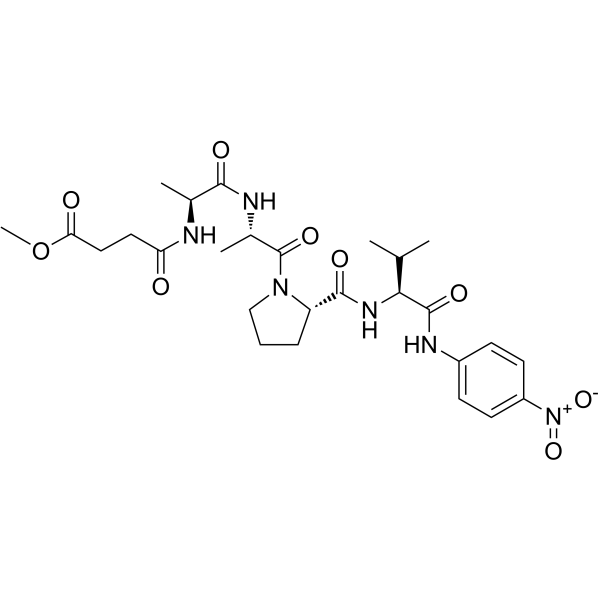MeOSuc-Ala-Ala-Pro-Val-pNA

MeOSuc-Ala-Ala-Pro-Val-pNA structure
|
Common Name | MeOSuc-Ala-Ala-Pro-Val-pNA | ||
|---|---|---|---|---|
| CAS Number | 70967-90-7 | Molecular Weight | 590.62500 | |
| Density | 1.297g/cm3 | Boiling Point | 908.4ºC at 760 mmHg | |
| Molecular Formula | C27H38N6O9 | Melting Point | N/A | |
| MSDS | USA | Flash Point | 503.2ºC | |
|
Thrombospondin-1 restrains neutrophil granule serine protease function and regulates the innate immune response during Klebsiella pneumoniae infection.
Mucosal Immunol. 8 , 896-905, (2015) Neutrophil elastase (NE) and cathepsin G (CG) contribute to intracellular microbial killing but, if left unchecked and released extracellularly, promote tissue damage. Conversely, mechanisms that constrain neutrophil serine protease activity protect against t... |
|
|
Neutrophil extracellular traps directly induce epithelial and endothelial cell death: a predominant role of histones.
PLoS ONE 7 , e32366, (2012) Neutrophils play an important role in innate immunity by defending the host organism against invading microorganisms. Antimicrobial activity of neutrophils is mediated by release of antimicrobial peptides, phagocytosis as well as formation of neutrophil extra... |
|
|
Inhibition of elastase by a synthetic cotton-bound serine protease inhibitor: in vitro kinetics and inhibitor release.
Wound Repair Regen. 7(2) , 106-18, (1999) A cotton-bound serine protease inhibitor of elastase (fiber-inhibitor) has been formulated for in vitro evaluation in chronic wound fluid. As a model to understand the properties of the inhibitor in wound dressings, the kinetic profile and in vitro release of... |
|
|
Mapping the extended substrate binding site of cathepsin G and human leukocyte elastase. Studies with peptide substrates related to the alpha 1-protease inhibitor reactive site.
J. Biol. Chem. 254 , 4027, (1979)
|
|
|
Effect of cadmium chloride exposure during the induction of collagen induced arthritis.
Chem. Biol. Interact. 238 , 55-65, (2015) The precise cause of autoimmune diseases such as rheumatoid arthritis remains uncertain. Collagen induced arthritis (CIA) in animals is the most commonly used model of human rheumatoid arthritis (RA). Exposure of humans and animals to toxic metals is widespre... |
|
|
Trappin-2/elafin modulate innate immune responses of human endometrial epithelial cells to PolyI:C.
PLoS ONE 7 , e35866, (2012) Upon viral recognition, innate and adaptive antiviral immune responses are initiated by genital epithelial cells (ECs) to eradicate or contain viral infection. Such responses, however, are often accompanied by inflammation that contributes to acquisition and ... |
|
|
Anti-HIV-1 activity of elafin depends on its nuclear localization and altered innate immune activation in female genital epithelial cells.
PLoS ONE 7 , e52738, (2013) Elafin (E) and its precursor trappin-2 (Tr) are alarm antiproteases with antimicrobial and immunomodulatory activities. Tr and E (Tr/E) have been associated with HIV-1 resistance. We recently showed that Tr/E reduced IL-8 secretion and NF-κB activation in res... |
|
|
Interference of PR3-ANCA with the enzymatic activity of PR3: differences in patients during active disease or remission of Wegener's granulomatosis.
Clin. Exp. Immunol. 129(3) , 562-70, (2002) Anti-neutrophil cytoplasmic antibodies (ANCA) against proteinase 3 (PR3) are strongly associated with Wegener's granulomatosis (WG) and are thought to be involved in its pathogenesis. Levels of PR3-ANCA do not always correspond to clinical disease activity. T... |
|
|
Interleukin-1beta, tumor necrosis factor-alpha levels and neutrophil elastase activity in peri-implant crevicular fluid.
Clin. Oral Implants Res. 13(5) , 470-6, (2002) The aim of this study was to determine interleukin-1beta (IL-1beta), tumor necrosis factor-alpha (TNF-alpha) levels and neutrophil elastase (NE) activity in peri-implant crevicular fluid (PICF) of smoker and nonsmoker patients, and to investigate their relati... |
|
|
Bcl-2-mediated resistance to apoptosis is associated with glutathione-induced inhibition of AP24 activation of nuclear DNA fragmentation.
Cancer Res. 58(23) , 5570-6, (1998) Studies on the mechanism of apoptosis in this laboratory support a model in which signal transduction involving caspase 3 leads to activation of a serine protease called Mr 24,000 apoptotic protease (AP24), which then induces internucleosomal DNA fragmentatio... |